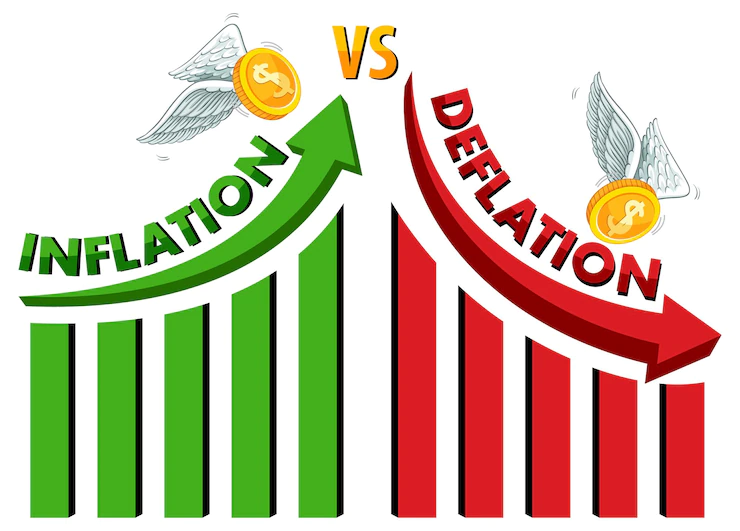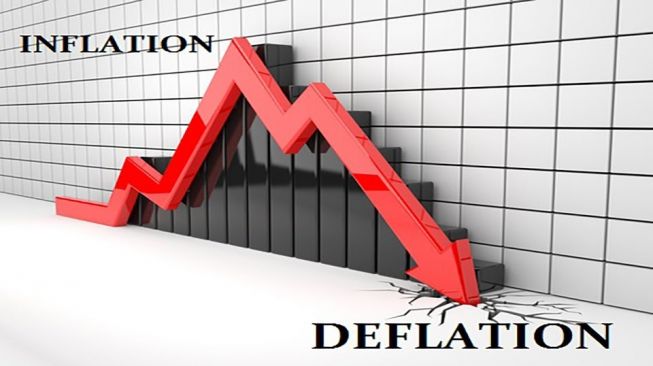Inflation and deflation are economic phenomena that have a significant impact on the economic stability of a country. Inflation and deflation are conditions associated with changes in prices for goods and services.
Definition Of Inflation

Quoting the Bank Indonesia website, inflation is a general and continuous increase in the price of goods and services over a certain period of time. In conditions of inflation, the purchasing power of the currency decreases. This means that, with the same amount of money, a person gets a smaller amount of goods and services than before.
Inflation is usually measured in annual percentages. A low and stable inflation rate is the target of most countries, which is pursued through economic policies.
Causes Of Inflation
One of the causes of inflation is the imbalance between demand and supply. High demand for a good or service, or scarcity can cause price increases.
In addition, the cause of inflation is the increase in production costs and the increase in money circulating in society. Public behavior that often predicts or is commonly referred to as expected inflation is also a cause of inflation. Another cause of inflation is economic and political chaos in a country, as happened in Indonesia during the riots of 1998.
Negative Impact Of Inflation
The direct impact of inflation that is too high is a decrease in people’s purchasing power, especially among the lower middle class. If people reduce spending, then economic growth will move slowly, stagnate, even decline.
In addition, unstable inflation will create uncertainty for economic actors in making decisions. Unstable inflation will make it difficult for people to make decisions on consumption, investment, and production, which will ultimately reduce economic growth.
According to Bank Indonesia, low and stable inflation is a prerequisite for sustainable economic growth ,which ultimately provides benefits for improving people’s welfare.
Definition Of Deflation
Deflation is the opposite of inflation. In simple terms, deflation is a condition in the economy in which the general level of prices for goods and services has a continuous decrease over a certain period of time. In deflation, the purchasing power of a currency increases because with the same amount of money, one can buy more goods and services compared to before.
At first glance, deflation seems advantageous because the prices of goods and services become more affordable for consumers. But deflation can be a double-edged knife, which means it can have a negative impact, especially for producers of goods or service providers. Deflation that occurs continuously can be detrimental to buying and selling activities. The decline in the price of goods and services often makes producers or service providers suffer losses because sales are unable to cover production costs and operating costs. If deflation gets worse, this can lead to job cuts (layoffs) to reduce the burden.
Causes Of Deflation
One of the causes of deflation is too much supply of the same goods at one time. In accordance with the principle of economy, the more supply of goods in the market (supply), the cheaper the price will be.
The second cause of deflation is a decrease in demand. When economic conditions deteriorate, consumer behavior often saves spending and saves money for more priority needs. This makes the demand for goods or services weaken, thus triggering their prices to decline.
An economic crisis or recession can also lead to deflation, due to a decrease in overall economic activity.
Deflation can also be caused by improper government or central bank policies, such as setting interest rates too high or limiting the money supply.
Negative Effects Of Deflation
Excessive deflation can lead to increased layoffs and unemployment. In addition, deflation contributed to the decline in the minimum wage.
Deflation is also could encourage more bad debts in banks and financial institutions. This is caused because many manufacturers or service providers who become debtors are in difficult conditions because their sales have decreased.
Deflation also has a domino effect on state income, namely taxes. By harming producers of goods and service providers, it automatically makes them unable to pay taxes as in normal conditions.
Continued deflation can also create economic uncertainty and make consumers put off buying because they expect prices to be lower in the future.
Implications: inflation and deflation
Here are the effects of inflation and deflation in some aspects of the economy:
Purchasing Power Of Money
In conditions of inflation, the purchasing power of money tends to decrease over time. That is, for the same amount of money the consumer gets less goods and services.
Conversely, in deflationary conditions, the purchasing power of money tends to increase over time. With the same amount of money, consumers can buy more goods and services.
Influence On Debt
Inflation tends to reduce the real value of debt. When prices rise, the amount of money that must be paid to pay off the debt remains the same, but the real value of the money decreases.
On the other hand, deflation can increase the real value of debt. When prices fall, the amount of money to be paid to pay off debt remains the same, but the real value of the money increases.
Impact on investment
Inflation can have a positive impact on investment. When the inflation rate is stable, investors can protect the value of their wealth by allocating funds to investment instruments that provide yields higher than the inflation rate.
Conversely, deflation can have a negative impact on investment. In deflationary conditions, asset values tend to decline, and investors may be reluctant to invest their money because of the risk of incurring losses.
Economic Stimulus
In some cases, inflation can trigger economic stimulus. Rising prices can encourage consumption and investment, which in turn can result in economic growth.
Conversely, deflation can be a challenge to economic stimulus. When prices fall, consumers tend to delay purchases, and investment may decline. This can hinder economic growth.
Conclusion
Inflation and deflation are normal phenomena in the economy. The challenge is to maintain a balance between the two (inflation and deflation) so that the inflation rate is neither too high nor too low. A moderate and stable inflation rate is considered a sign of a healthy economy.



